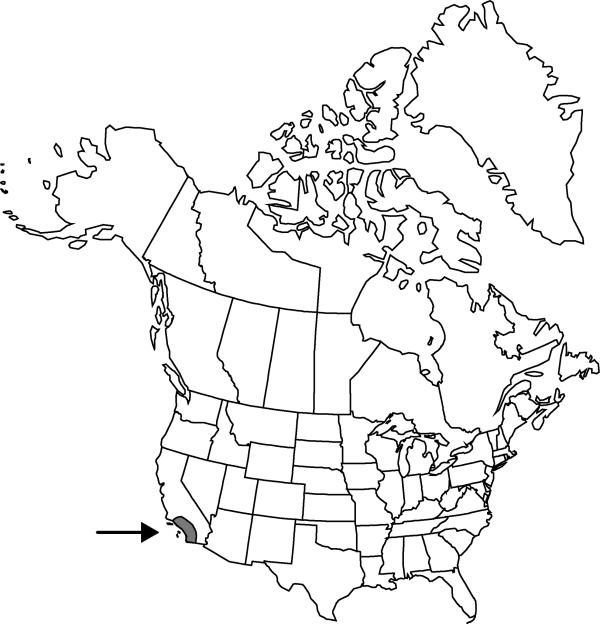familyChenopodiaceae
genusAtriplex
subgenusAtriplex subg. Obione
sectionAtriplex sect. Obione
subsectionAtriplex subsect. Arenariae
speciesAtriplex serenana
Difference between revisions of "Atriplex serenana var. davidsonii"
Man. S. Calif. Bot., 598. 1935.
Common names: Davidson’s orach
Endemic
Basionym: Atriplex davidsonii Standley in N. L. Britton et al., N. Amer. Fl. 21: 57. 1 916
Treatment appears in FNA Volume 4. Treatment on page 361.
FNA>Volume Importer |
imported>Volume Importer |
||
| (3 intermediate revisions by 2 users not shown) | |||
| Line 8: | Line 8: | ||
}} | }} | ||
|common_names=Davidson’s orach | |common_names=Davidson’s orach | ||
| + | |special_status={{Treatment/ID/Special_status | ||
| + | |code=E | ||
| + | |label=Endemic | ||
| + | }} | ||
|basionyms={{Treatment/ID/Basionym | |basionyms={{Treatment/ID/Basionym | ||
|name=Atriplex davidsonii | |name=Atriplex davidsonii | ||
|authority=Standley | |authority=Standley | ||
| + | |rank=species | ||
|publication_title=in N. L. Britton et al., N. Amer. Fl. | |publication_title=in N. L. Britton et al., N. Amer. Fl. | ||
|publication_place=21: 57. 1 916 | |publication_place=21: 57. 1 916 | ||
| Line 29: | Line 34: | ||
|elevation=10-500 m | |elevation=10-500 m | ||
|distribution=Calif. | |distribution=Calif. | ||
| − | |discussion=<p>L. Abrams and R. S. Ferris (1923–1960, vol. 2) maintained this taxon at the specific level; however, apart from the more apparently veined fruiting bracteoles and reduced staminate inflorescence, < | + | |discussion=<p>L. Abrams and R. S. Ferris (1923–1960, vol. 2) maintained this taxon at the specific level; however, apart from the more apparently veined fruiting bracteoles and reduced staminate inflorescence, <i></i>var.<i> davidsonii</i> is otherwise identical to <i></i>var.<i> serenana</i>. It is often found growing with seepweed, samphire, numerous salt-tolerant annuals, other saltbush species.</p> |
|tables= | |tables= | ||
|references= | |references= | ||
| Line 38: | Line 43: | ||
-->{{#Taxon: | -->{{#Taxon: | ||
name=Atriplex serenana var. davidsonii | name=Atriplex serenana var. davidsonii | ||
| − | |||
|authority=(Standley) Munz | |authority=(Standley) Munz | ||
|rank=variety | |rank=variety | ||
| Line 52: | Line 56: | ||
|publication title=Man. S. Calif. Bot., | |publication title=Man. S. Calif. Bot., | ||
|publication year=1935 | |publication year=1935 | ||
| − | |special status= | + | |special status=Endemic |
| − | |source xml=https:// | + | |source xml=https://bitbucket.org/aafc-mbb/fna-data-curation/src/2e0870ddd59836b60bcf96646a41e87ea5a5943a/coarse_grained_fna_xml/V4/V4_706.xml |
|genus=Atriplex | |genus=Atriplex | ||
|subgenus=Atriplex subg. Obione | |subgenus=Atriplex subg. Obione | ||
Latest revision as of 22:00, 5 November 2020
Staminate inflorescences of solitary, terminal, subglobose glomerules. Fruiting bracteole 3-veined, 2.5–3.5 × 2.4–3.7 mm.
Phenology: Flowering spring–fall.
Habitat: Bluffs, alkaline sinks and drainages
Elevation: 10-500 m
Discussion
L. Abrams and R. S. Ferris (1923–1960, vol. 2) maintained this taxon at the specific level; however, apart from the more apparently veined fruiting bracteoles and reduced staminate inflorescence, var. davidsonii is otherwise identical to var. serenana. It is often found growing with seepweed, samphire, numerous salt-tolerant annuals, other saltbush species.
Selected References
None.
Lower Taxa
None.
